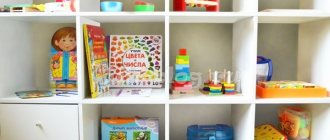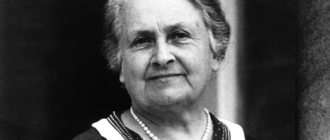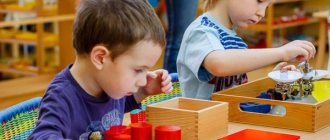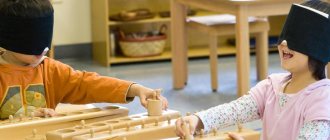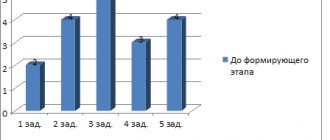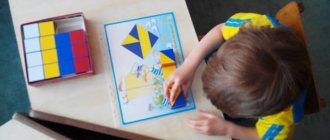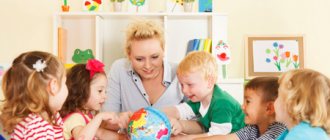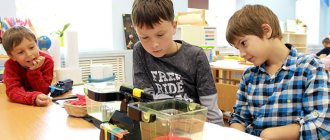The beginning of the twentieth century literally divided the history of mankind into before and after, because life underwent incredible changes and required new moral guidelines, approaches to education and upbringing, and the organization of work and leisure. It was a period of bold experiments and amazing discoveries. Despite all the social upheavals, people of the twentieth century became freer and more progressive, which means that upbringing and education had to change a lot, because kids had to grow up in a completely new world.
The observations and innovations of the Italian doctor Maria Montessori became a real breakthrough in pedagogy, since her approach simultaneously had both a good theoretical basis and brilliant results in practice. In this article we will try to highlight all the main features of Montessori education and discuss for which children classes using the M. Montessori method are best suited.
A little history
Maria Montessori (Italian doctor, anthropologist, teacher) is the creator of a unique education method that became popular in the first half of the 20th century. Maria began her medical career as a physician’s assistant, and while working in an institution for children with disabilities (a psychiatric hospital), she became interested in methods of treating such children. Montessori came to the conclusion that their intellectual problems were partly not only medical, but also pedagogical.
Montessori saw how lonely these children were, no one worked with them, they didn’t even have toys. And then she began to bring the children the simplest objects: scraps, boxes, beads. And the kids seemed to come to life.
Maria Montessori developed a unique method of education, which she initially used in working with children with disabilities
Subsequently, Maria took the position of director of the Orthophrenic Institute, specializing in training teachers to work with sick children. There was a school at the institute where Montessori taught children herself. The result was obvious: many students passed the exam at the secondary school level.
The doctor gradually improved her system of education and training, and then decided to apply it to healthy children - special kindergartens were organized for children 3-7 years old.
Montessori schools have gained great popularity in Europe (especially in Germany, Austria, the Netherlands), the USA, Japan, and North Korea. In Russia, this technique was unavailable for a long time.
People's Commissar of Education A.V. Lunacharsky tried to conduct a series of experiments to introduce Montessori pedagogical principles into the system of Soviet preschool education. However, Stalin did not approve of the innovation: the dissemination of the methodology was banned, and Maria Montessori was labeled a “reactionary teacher.”
This pedagogical system was not remembered in our country until the 90s. It was at this time that the first benefits began to appear. Today, many kindergartens and early childhood development centers in Russia use this unique method, and mothers independently study at home with their children.
Today, many mothers are keen on the Montessori system and use it in home activities with their children.
The logical continuation of this education is primary school, but in Russia, due to strict education standards, this is problematic. There are either rare experimental sites operating on the basis of regular schools, or private schools (“on paper” they are considered ordinary). Although abroad, Montessori training ends at 10–12 years.
A brief description of the essence of Maria Montessori's pedagogy
Briefly, the essence of the Montessori method can be conveyed in one phrase : “Help me do it myself.” The author of the system was deeply convinced that powerful internal potential is hidden in every baby from birth. It is important to create conditions for it to open up, and then a harmonious personality will be formed.
The Montessori system involves education without any coercion. The child should naturally awaken a natural interest in learning. This takes into account his physiological and psychological needs at the moment. The key point will be “what the child wants.”
Basic principles of education
In general, the methodology is based on a number of principles:
- Observation of the child. The task of an adult (parent, educator) is to closely study the baby and understand the features of his inner world.
- Humanism is the complete absence of psychological violence and the use of totalitarian pedagogical methods.
- Freedom, independence. It is unacceptable to suppress a child’s energy; on the contrary, it must be directed in a creative direction.
- Minimum influence from an adult. He simply helps the child understand the subject he has chosen, unobtrusively guides him, and creates the necessary developmental environment.
- Individual approach. The characteristics of the child and the degree of his activity are taken into account.
According to Montessori, the leading motivation for a child is the desire for knowledge, curiosity, and enthusiasm. In this case, education is organically intertwined with learning. The baby develops independence skills and at the same time the emotional world is enriched and self-esteem is formed.
Sensitive periods: at what age what to develop
The Montessori method identifies important sensitive periods. This is the age at which the baby most easily and naturally comprehends certain things:
- Perception of order (0–3 years). Children learn to pick up after themselves, maintain cleanliness, wipe up spilled water, collect spilled cereals, and wash dishes. According to the method, at 4 years old it is already more difficult to introduce the baby to all this.
- Development of actions, movements (1–4 years). Coordination is actively developing and muscles are strengthening. It's time to explore children's playgrounds with their ladders, slides, and swings.
- Sensory development (0–5.5 years). Understanding the world through sounds, smells, tactile perception. Ideas about color, size, shape are formed.
- Perception of small objects (1.5–5.5 years). This is the development of fine motor skills. It is at this time that manipulation with various objects is important: rearranging beads, stringing them on a thread, sorting cereals, beans, peas, putting together puzzles, etc.
- Speech development (0–6 years). Various cards and other visual aids and books help with this. Here the role of the adult is already increasing.
- Development of social skills (2.5–6 years). Again, everything should be learned at ease; it is unacceptable to force a child to say hello or say “thank you.”
When the time has not yet come or, on the contrary, has been missed, it will be difficult or simply uninteresting for the child to master a certain skill.
Video: what is the Montessori method
Freedom of the child and the role of the educator
By the role of a teacher we will understand not only employees of child care institutions, but also the child’s parents and other adults who decided to use this method.
Montessori invites the teacher to master the consciousness of a scientist. Take on a more specialized role as an observer of the child (like a scientist in a laboratory observing microorganisms through a microscope) rather than simply monitoring his safety and assigning tasks.
“I firmly believe that we should cultivate in our teachers the spirit of a scientist, and not instill in them the skills of mechanical work.”
The teacher's task is to meaningfully monitor the child. The teacher should not impose knowledge or purposefully teach the child. He can sometimes only slightly direct the child’s actions (without nevertheless allowing him to feel his presence). And he can help only at the request of the child himself.
"Wait and watch." This is the motto of the teacher. Let's wait and be always ready to share with the child his successes and difficulties. He himself will ask us for help, and then we will have to respond joyfully. Let us be patient as we watch his slow progress. And we will show joy and enthusiasm when the child wants to share his successes with us. If we could say, “We have respect and interest in the actions of our children, we treat them as we would like to be treated,” then we would certainly understand the great principle of education and would undoubtedly become a model good teachers."
The child himself is given the task of being free and doing whatever he wants in the environment, without disturbing other children. But even so, the teacher should not be a passive observer, but should be an active scientist:
“The freedom of the child must have a limitation, the criterion of which is the collective and its interests, and a form that is commonly called good upbringing. To do this, you need to study each child individually, finding out what in his behavior can cause offense and irritation to others, and what inclinations can subsequently lead to rude behavior. In all other respects - in all manifestations that have some benefit - whatever they may be and whatever form they are expressed in - everything should be allowed, but with mandatory supervision from the teacher.”
In such a free environment, the child learns and develops independently, through Montessori materials (parents call them “Montessori toys”), which contain self-learning functions.
The classic Montessori group consists of children from 2 years 8 months to 6 years. All children study in the same group, not separated by age. This is a good solution, since the younger ones learn from the older ones, take from them examples of behavior, actions with objects, etc.; and the elders learn to teach the younger ones, showing sensitivity and care, they take on the role of leader and mentor. This interaction helps establish a friendly atmosphere in the group.
Comparison of the Montessori method with other early development systems
As you know, the Montessori system is not the only method of early childhood development, so it will be interesting to compare it with other systems.
Table: comparison of the Montessori system with other early development methods
| Author of the method | Distinctive features |
| Zaitsev | The system offers a game form of work. And Montessori classes are not a game, but, in fact, the ordinary life of a child. Here you need a lot more material than tables and a set of cubes. |
| Glenn Doman | Doman training is carried out mainly with the help of cards, there is no impact on the sense of touch. Montessori places great importance on the tactile function. |
| Nikitins | Although classes according to Nikitin are somewhat reminiscent of the Montessori method (the parent is perceived as a senior comrade, and not an inspector), in this system a significant role is assigned to the hardening of children, which is not the case with Montessori. |
| Cecil Lupan | This system is aimed at maximizing active learning in the first year of a child’s life. In Montessori, everything is served in doses, in equal portions at different ages. The child is constantly in the process of learning. |
Pros and cons of Montessori pedagogy
Of course, the Montessori method is unique and leaves few people indifferent. Its supporters highlight the following significant advantages of the pedagogical system:
- The technique can be adapted to different cultures, because it is based on the basic needs of the child.
- The children learn everything with pleasure, because they themselves choose what to do. There is no boredom, no fear of a difficult task imposed by an adult.
- Children who were trained according to Montessori cope better with household responsibilities than others, are more responsible, can properly manage their time, know how to keep themselves busy, while respecting the needs of others.
- Didactic aids and exercises with them contribute to the accelerated development of mental activity, logic and motor skills.
The Montessori method promotes the accelerated development of intelligence and logical thinking
However, the technique also has its opponents. And their criticisms can be summarized in the following theses:
- There are no spontaneous creative games, for example, role-playing games. And this is very important for the development of the child’s imagination, his emotional sphere. The system does not pay enough attention to creative activities (fine arts).
- Predominant intellectual development distorts normal psychology and deprives the child of the carefree joy of childhood. Montessori underestimates the role of play in a child's development and replaces it with useful activities with teaching aids.
- In the pedagogical process, reading fairy tales is ignored. Maria Montessori considered them a departure from reality and replaced them with a realistic description of objects. Hence, the child does not develop the ability to empathize, fantasize, or conduct an internal dialogue with the characters of the work.
- A child who studied at home using this system (and also who attended such a kindergarten) will find it quite difficult in a regular school, where all the students sit at their desks, performing a specific task from the teacher. In addition, such a student has already formed an attitude towards an adult as an assistant, and not as an authority.
- Many children are brought up in families with an authoritarian order and therefore not every mother is able to act as an older comrade or assistant (as the Montessori system assumes).
- The technique is not suitable for all children. This is a bad option for overly mobile, active guys who have problems with perseverance and concentration. In addition, if the child has expressed creative abilities, then they will be unclaimed, since the technique is based on a rational way of understanding the world.
The Montessori method is not suitable for an overly active, active child, since it is aimed at quiet activities that require concentration.
Video: for whom the Montessori method is not suitable (a specialist explains)
Philosophy of the Montessori method
Any development method is, first of all, the values of the author and his views on education. The exercises themselves are only means of achieving these values. The main goal that a child should achieve according to Montessori is to join adult society, mastering its inherent qualities.
“With us, a child learns to move, and not sit motionless in one place, he acquires behavioral skills not for school, but for future life, thanks to habit and practice, he learns to easily and correctly perform simple actions necessary for life in society.”
The Montessori method is based on accepting the nature of the child, who from birth acts as an inquisitive and free explorer who strives to actively explore the world and master skills. An adult should under no circumstances interfere with the child’s activity. As M. Montessori herself warns:
“We can only guess about the consequences of suppressing the child’s spontaneous actions during the period when he is just learning to be active: perhaps we are suppressing life itself in him... It is necessary to resolutely reject everything that interferes with the child’s spontaneous manifestations and forces him to do something. Of course, here we are not talking about useless and dangerous actions that should be stopped.”
The Montessori method provides an individual approach to the child, where he independently chooses his own activities and their duration, thus he develops at his own rhythm based on his own desires. Classes take place in a specially created Montessori environment, which mainly consists of didactic Montessori material (we will talk about this a little later).
What the Montessori environment does not have are heavy, fixed desks, which, in her opinion, “shackle the souls” of children, forcing them to study. There are also no grades or all kinds of encouragement from adults: treats, certificates, awards, etc. A child in a free environment acts based on his own interests and the interests of his development, and external rewards are only a mockery of his feelings and personality. Therefore, in this technique there are no rewards from other people, but there is pleasure from independently satisfying your desires.
Many parents think that Montessori development means providing the child with Montessori materials and leaving him alone. But Montessori is, first of all, a free child and an observant adult. How many parents are ready to give their child freedom and make an effort not to take it away? And also just monitor the child’s activities without teaching or interfering with it?
Creating a nurturing Montessori environment at home
Since in the Montessori system the primary role is played by the conditions for unlocking the child’s potential (and not the imposition of ready-made templates), the role of the developmental environment increases. In a child’s nursery, it is advisable to highlight several key areas of development:
- Practical activity area. Its task is to instill self-service skills and perform simple household functions. Functional toys are placed here: dishes, cleaning items (preferably real, not toy ones - sponges, rags, brushes, etc.), aids with buttons, snaps, zippers, lacing, etc.
- Zone of sensory development. These are various small objects, puzzles, boxes of cereals, sensory bags, insert molds, sets of geometric shapes of different shapes, sizes, colors, musical instruments, hammers, jars with aromatic substances, scraps of fabrics of different textures, lacing, etc. In general, there are objects for the development of the senses. In general, Montessori paid special attention to the development of touch and fine motor skills, believing that it was precisely precise actions with small objects that improved thinking, speech, memory, and attention.
- Native language zone. Here children learn letters, learn to read, prepare to master writing skills, and develop sound perception. The filling of the zone will be appropriate: cards with rough (velvet paper) letters, syllables and whole words, just figures of letters, their stencils for tracing, semolina with a tray (on which the child will write letters), etc.
- Math zone. Here there are boxes with numbers (cards and three-dimensional figures), signs for mastering the operations of addition, subtraction, multiplication and division, barbells, spindles, Seguin boards, a set of gold beads, etc. Moreover, it is not necessary that the preschooler master all mathematical operations (especially multiplication and division): it all depends on his enthusiasm and individual pace of development.
- Natural science or space zone. Here the child gets acquainted with the world around him (including the universe), learns to classify living and inanimate nature, and learns the relationships and patterns in it. The child will have the opportunity to conduct real experiments: for example, make sure that a tree burns and a stone sinks in water, build a mini-volcano that will erupt, etc. In the zone there are various cards with images of plants, animals, posters on the human structure, a globe , world maps, models of planets of the solar system, etc., materials for experiments.
- Area of development of gross motor skills, or motor. It is located away from other areas and contains sports equipment.
It is clear that at home (especially if the children's room is small) it is often unrealistic to arrange all these areas, but try to at least allocate separate shelves, for example, in a rack for each group of benefits.
Photo gallery: rooms for small children, decorated according to Montessori conditions
The nursery has a wonderful corner for developing gross motor skills.
Even a blanket on the bed provides an opportunity for sensory development
Such a wardrobe from an early age teaches the child to be independent and develop self-care skills.
The parents' task is to periodically change the contents of the upper and lower shelves so that the child can choose his own study aids
Montessori material
You may have seen some of the Montessori material already above in the Montessori environment section.
Montessori's didactic material was not created from scratch, partly it is the developments of the “Gifts of Froebel”, already known for 200 years (Froebel is a German teacher, founder of the first kindergarten in 1836), partly it is the methods of Seguin and Itard. Montessori refines their material and also creates his own.
The material is made mainly from wood and other natural materials. Each group is allocated one or two copies of each type of Montessori material, which can cause some indignation in children. Children are not allowed to interfere with another child who is already working with a set, and therefore have to wait for him to become free (but the child usually does not wait, but takes another set). Upon completion of actions with the set, the child must independently fold it and take it to the shelf, only after that the set is available to other children. This is how the Montessori environment develops in children patience, discipline and a sense of the personal boundaries of other people.
The peculiarity of Montessori material is the built-in control function when operating the tool, when the child himself sees his mistakes. This is an important element in this system. For example, a block with cylinders. If the child places the cylinders incorrectly, some will be too deep in the hole, and some will rise above the border level.
The principle of Montessori materials can be partially transferred to many household items at home (but they will not have a control function): jars with lids, boxes, fasteners, clothespins, various gifts of nature (pebbles, sand, acorns), foods (cereals, pasta , beans) and so on. All this is available to the child at home, with the proper approach of the parents.
It is also worth considering that in a Montessori environment, all material is located on open shelves and chests of drawers, no higher than the child’s eye level, so that he can calmly and at any time come up and take it.
Training rules and materials for classes
It is interesting that the most ordinary objects can act as toys using this method: a basin, a strainer, napkins, a spoon, a sponge, etc. Along with them, there are also specially designed Montessori aids: for example, the Pink Tower, the Brown Ladder, insert molds , numerical machines, frames with fasteners, etc.
Along with ordinary objects, the method involves the use of special aids developed by Maria Montessori
In general, didactic materials in the Montessori system arouse keen interest in the child, involve practical activity (rather than abstract explanations from an adult), provide the opportunity for repeated repetition, independent correction of mistakes, and foster independence and independence.
When studying didactic material, you need to teach your child to follow certain rules:
- All manuals and toys are publicly available. But the baby must learn that they cannot be scattered around the room, but must be put in their place.
- The child always chooses the material for the lesson himself.
- An adult should tell the child that they should not switch attention from one manual to another: the exercise should be completed.
A teacher or parent needs to praise the child more often and respect his efforts. This will further stimulate independence and self-confidence.
In general, as far as Montessori home education is concerned, any parents can make their entire home a “developmental environment.” To do this, in addition to purchasing appropriate toys, you need to allow the child to participate in the everyday life of the family: doing all possible cleaning, caring for plants, pets, repairing their toys, and doing handicrafts.
Parents (fans of the Montessori system) can organize a “developmental environment” at home - allow children to participate in cleaning and other household activities
Zoning of premises
According to the Montessori system, the following main zones are distinguished:
- Practice or real life . Here children will learn basic everyday skills. Cleaning and washing supplies, buttons and laces can be placed here.
- Perception or sensory . For children to be able to develop, all objects located in this zone must be of different shapes, weights, sizes and shades. You can use jars, boxes, etc. The baby will train fine motor skills and learn to distinguish things by tactile sensations. In addition, in this zone he will be able to train his memory and attention.
- Mathematicians . This zone promotes the development of abstract thinking, fosters perseverance and patience. Materials can be counting sticks, figures (squares, triangles, etc.).
- Language . Here children can learn to write and read, therefore in this area there should be various cubes with letters, copybooks and alphabet books.
- Space . As the name implies, this area is used so that the baby can get acquainted with the world around him. For example, with other countries, weather, animals, etc. In this area you can place animal figures, maps, books, etc.
This is the author’s version of zoning, but more modern variations of the technique involve the use of zones for physical development, music, art, dance, foreign languages, etc. But there is rarely enough space for them in average apartments. But such in-depth zoning comprehensively develops the child.
Real life zone
This zone is called practical, since its main task is to accustom the baby to the everyday side of life and instill hygiene habits.
Classes in this area help children master the following skills:
- how to take care of yourself (fold clothes, perform hygiene procedures, eat and even cook);
- how to care for the surrounding space (clean, water flowers, feed pets);
- how to move (walk quietly, in a straight line);
- how to create communications (communicate with parents, educators, peers, in society).
In the area under consideration, you can use materials such as:
- boards with buttons, straps, clasps, etc.;
- dishes of different shapes and sizes;
- indoor plants and cut flowers;
- broom and dustpan.
In principle, you can use any item that is used in everyday life. But the use of toys is undesirable - all things must be real. Although you should not forget about safety rules and such items as scissors, knives, etc. use only when the child begins to understand what danger this thing can bring and how to use it correctly.
Sensory area
This area promotes the development of sensory perception.
Helps improve:
- fine motor skills;
- vision;
- touch;
- hearing;
- baric feeling (feeling of weight).
To ensure that children can fully play in this area, the following items are used:
- multi-colored signs;
- nesting cylinders of different sizes;
- signs with rough and smooth surfaces;
- fabric scraps;
- bells;
- heavy and light objects;
- fragrant bags.
The main difficulty of equipping this zone is to emphasize all sensory senses without highlighting any one. Therefore, it is important to collect a variety of materials. Some will affect hearing, others - vision, others - smell, etc.
Math Zone
The areas of sensory and mathematics are interconnected. Comparing materials with each other, the child measures them by performing mathematical operations. The sensory zone only prepares the baby for numerical operations. In mathematics, children are already beginning to master mathematical concepts.
This will require special materials:
- numbers made of fabric (can be made of paper, but then the risk of tearing them is higher);
- cards with numbers;
- rulers;
- beads for mastering basic mathematical operations;
- circles divided into shares;
- geometric figures.
The main thing is that the materials are visual. It is easier for a child to remember a number if he can touch it or turn it in his hands.
Language zone
This zone is closely connected with the sensory zone and develops fine motor skills.
That is why almost all the equipment in it is aimed at developing sensory sensations:
- letters made of tactilely pleasant materials;
- inserts;
- movable alphabet;
- frames for shading;
- intuitive reading cards.
All these devices contribute to the correct formation of speech skills and their development. The materials expand children's vocabulary.
Space zone
The second popular name for this zone is natural science education. Children here receive information about the environment, subject connections, learn historical facts and gain an understanding of biology, geography, natural history and other sciences.
So that the guys can gain as much knowledge as possible in this zone, you can leave the following equipment:
- encyclopedias and reference books (naturally, for children, with an abundance of colorful pictures);
- maps (geographical and natural);
- models (for example, solar system, mountains, volcanoes);
- materials on the typology of animals and plants;
- calendars;
- materials for experiments (something safe, such as potatoes and iodine to see starch);
- seeds and leaves of the plant.
In general, these can be any materials thanks to which the child can better get to know the world where he lives.
Tips for organizing home activities with children of different ages
It is advisable to divide recommendations for parents on homework by age.
Up to a year
From the age of 5 months, a mother can use busy boards, because these developmental aids were invented by Maria Montessori (originally they were wooden, but today they have been adapted into soft rugs and books). You can also use tactile exercises with pads filled with cereals, pebbles, and foam. Let the baby just touch them.
Interestingly, the idea of creating a busy board (developmental board) belongs to Maria Montessori
Another type of activity is holding out objects to the toddler and transferring them from one child’s hand to another.
Video: Montessori educational toys for babies
From one year of age to 3 years
The range of exercises is expanding, the following options are being added:
- Games with water. The baby catches small toys and pebbles from a bowl of water (with his hands or a net), pours water from a watering can, and pours liquid from one container to another.
After one year, you can already offer your child manipulations with water.
- Stringing objects onto a support (based on the pyramid principle).
- Games with a spoon (catching objects with it).
- Exercises with clothespins (fastening them to a rope or fabric).
- Fasteners, lacing.
- Sorting items poured into one container (buttons, pasta, small toys, etc.).
After a year, you can introduce exercises for sorting cereals and small items
- Drawing on sand with a stick, brush, etc.
- Feeding a plastic toy (through a cut-out mouth).
- Modeling from plasticine (rolling balls, sausages).
Video: Montessori water games
For ages 2–5 years
Wooden toys (geometric figures, etc.), puzzles, and didactic games to get acquainted with the outside world are already being actively used. The study of numbers and letters begins.
In the period from 2 to 5 years, the study of numbers and letters begins
In addition, you should actively involve the child in performing household chores: helping with washing, cleaning, cooking (for example, kneading dough, arranging fruits by color).
After 5 years
At this age, perseverance develops, and the previously mastered skills of self-care and house cleaning become more complex. Math and reading are being actively taught. The child is offered exercises to practice writing skills (printed shading, copywriting, drawing letters on a blackboard with chalk, etc.). Games to get acquainted with the world around us (for example, on the theme of space) are becoming more diverse.
Interest in sensory play is already declining at this age. You can increase it, for example, by practicing with kinetic sand.
Useful literature about the Montessori development system
Parents who decide to teach their child at home using the Montessori system will find it useful to read the following publications:
- Montessori M. Help me do it myself. - M. 2000
- Montessori M. Children's home: Method of scientific pedagogy. - Gomel, 1993.
- Montessori M. The importance of the environment in education // Private school. - 1995. - No. 4.
- Montessori M. Teacher training: // Almanac “MAMA”: Scientific and methodological publication of the Interregional Alternative Montessori Association. — Vol. 1. - M., 1994.
- Dichkovskaya I.N., Ponimanskaya T.I. Education for life: the Montessori educational system. - M., 1996.
- Montessori M. The mind of a child // Montessori. - M., 1999.
- Afanasyeva T. Teach according to Montessori. - M., 1996.
- Boguslavsky M.V., Sorokov D.G. Yulia Fausek: Thirty years of the Montessori method. - M., 1994.
- Hiltunen E. Author's program of education and training in Russian Montessori kindergarten and primary school. - M., 2000.
- Pedagogy M. Montessori: Course of lectures. — Parts 1–2. - M., 1992–93.
- Doubtful K.E. How to help a child build himself? (Conversations about Montessori pedagogy). - M., 1999.
- Doubtful, K. E. Montessori Home School. 2 years / K. E. Doubtful. - M., 2014.
- Dance, Marie-Helene 60 lessons with a child using the Montessori method / Marie-Helene Place. - Moscow, 2014.
- Orlova, Daria The Big Book of Montessori / Daria Orlova. - M., 2011.
- Hainstock, Elizabeth Genius is taught from birth. Montessori system at home / Elizabeth Hainstock. - M., 2012.
